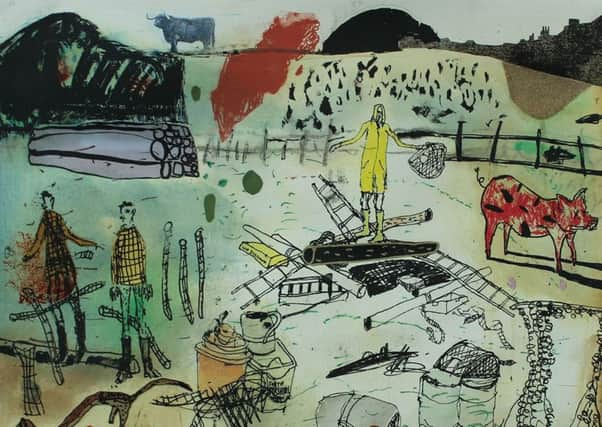Art review: Gray's School of Art Degree Show 2017


Gray’s Degree Show 2017 ****
Gray’s School of Art, Aberdeen
Praise be! There will always be bodies of work in which the journey is evident (but they are few) and others in which the journey doesn’t matter (even fewer). But, generally, if someone has spent the last year investigating the topography of Caithness peatbog, or the material properties of pigment made from beetroot, I’d prefer to know about it. In the kaleidoscope of a degree show, with fresh hopes around every corner, it feels all the more important.
Often, success in this context depends on having something to say (which almost everyone does) and happening upon a way to say it which brings out something fresh. Megan McDonagh is a painter, but is interested in visual impairment. Her work is in ceramics: 14 unfired, broken pots to represent countries in which cataracts cause at least half of unnecessary blindness, and beautiful glazed pots and braille dominoes which viewers are invited to handle. While strong visual objects, they speak with particular relevance to the subject because they can be experienced through touch.
Advertisement
Hide AdAdvertisement
Hide AdBrooke-Hayley Andrews is trying to say something about the issue of head trauma in sportsmen and women, and has made semi-abstract pieces using paint and sculpted fabric. It’s a difficult subject, and you can see her working her way through it, looking for a way to explore it which is not illustrative or didactic. Svetlana Panova takes a thoughtful look at the meaning of home, printing and projecting photographs on to blinds, shower curtains and wallpaper.
Hannah McIver is interested in education, and has taken a copy of WO Lester Smith’s 1950s treatise on the subject and doctored its pages in the manner of Tom Phillips’ A Humument, creating a new and rather beautiful text of her own. Her other work here is by the local young people who participated in her “Snapshot workshops” in photography and film. Kerri Ogg’s photographs of wind turbines in the North-east landscape are immediately accessible, but are also a thoughtful exploration of what it means to change a landscape, for the better or the worse.
The pipe dream for many at degree shows is to sell their work, and Rebecca Bisset has subverted this by opening a shop. With bright branding, T-shirts, baked bean tins and colourful prints of Duchampian urinals, she questions the relationship between art and merchandising. Alice Martin’s show is a museum, based around five objects from local collections. For her ‘Museum of Dispensability’, she has chosen very ordinary things and produced replicas of them using 3-D printing. Rebekah Chisholm takes a pertinent look at the selfie, inviting her audience to respond with emoji stickers.
At Gray’s, this is the first year of graduation in the new Contemporary Art Practice (CAP) course, incorporating what was previously sculpture, printmaking, fine art photography and electronic media. There are very few students working in the last two this year, though this might be no more than coincidence.
Painting remains a separate course, a small group this year, but a distinctive one. David Rae’s paintings of half-remembered spaces, balancing a dark palette with bursts of bright background, are beautifully done. Suzann Ross’s paintings of archives and libraries are very good, and make a thoughtful comment about the endurance of paper archives, even in a digital age. Hugh Morton’s crowd scenes combine skills in painting and drawing; his large painting of disparate individuals crossing one another’s paths in the snow is well worth a look.
Both Jessica Barrie and Anthony Carrick experiment with what happens when painting is pushed out into three dimensions. Ameena Mahmood does too, and her body of work exploring informal settlements on the edges of the world’s cities shows an impressive unity of ideas and aesthetics. CAP student Alexa Thomson uses film footage of some of the world’s most famous paintings to explore the boundaries of still and moving image.
As in every degree show this year, there is a marked return to making things, and doing it well. Aigita Kalmina is interested in materials, and has clearly enjoyed pushing various materials in new directions and then making sculptures out of the results. Yvonne Bathgate has made a quirky and interesting set of stones which seem to have an inner life: one belches out smoke, another has a pulsating heart. Aiden Milligan is a printmaker whose work builds up a kind of personal mythology relating to his homeland in South-west Scotland. Aberdeen might be the furthest-flung of Scotland’s big four art schools, but there is still plenty of strength in its art graduates to merit a visit to the far North-east.
*Until 26 June